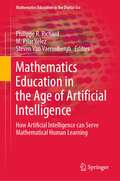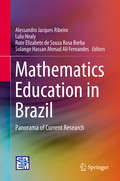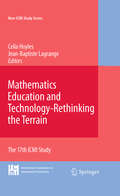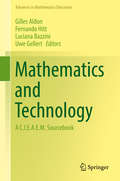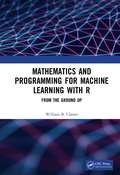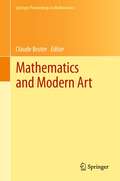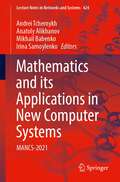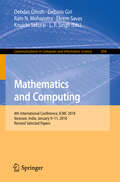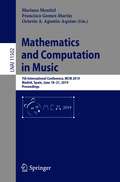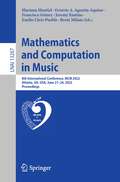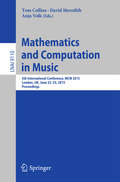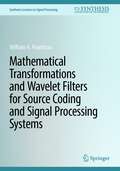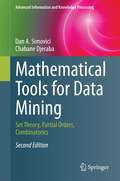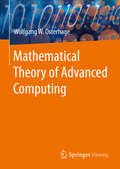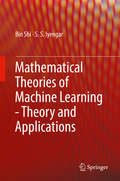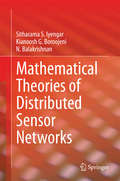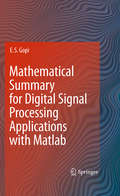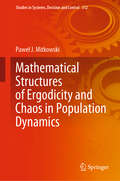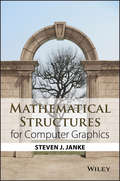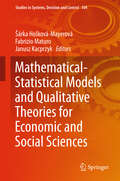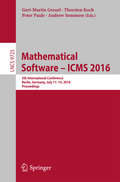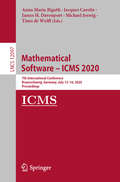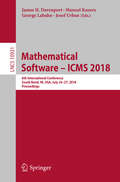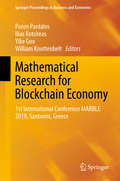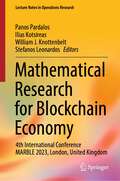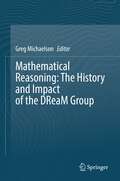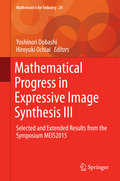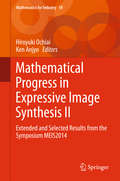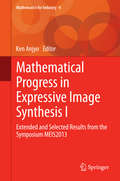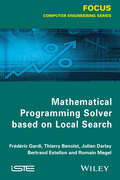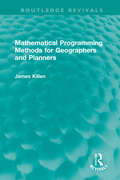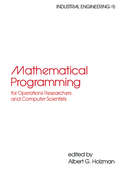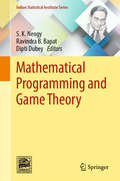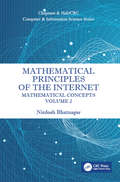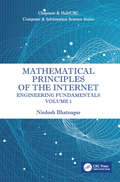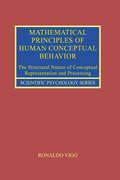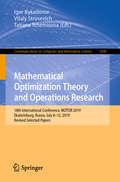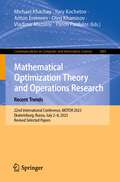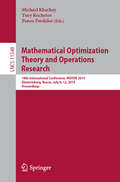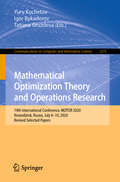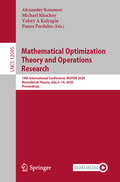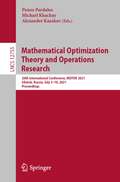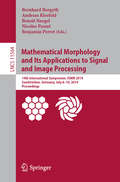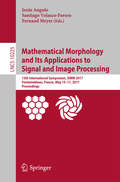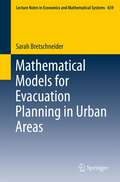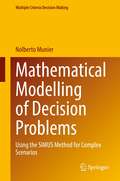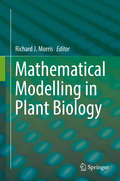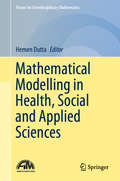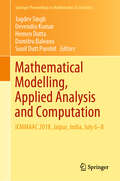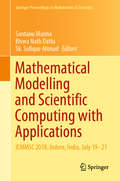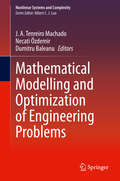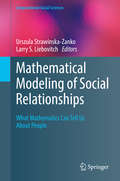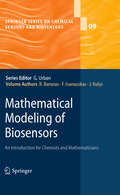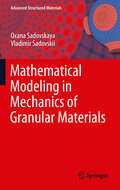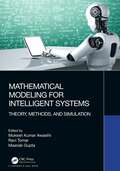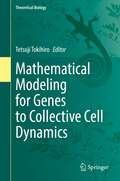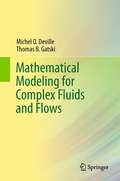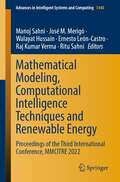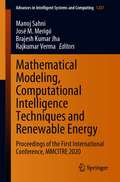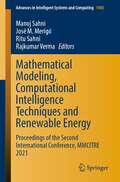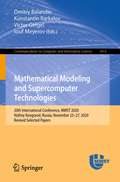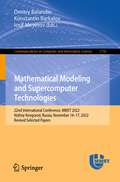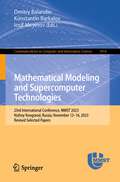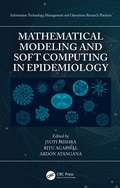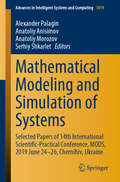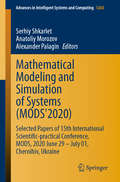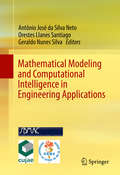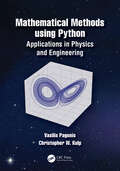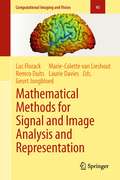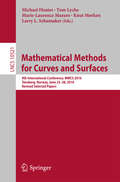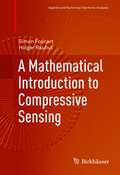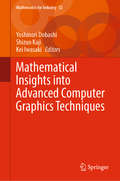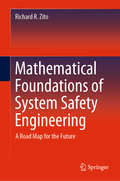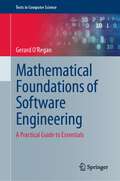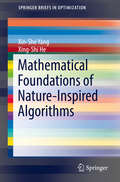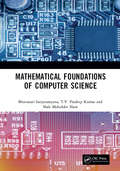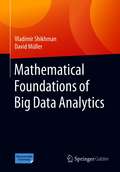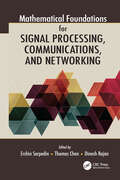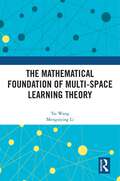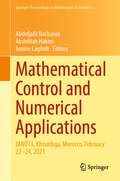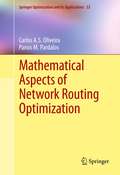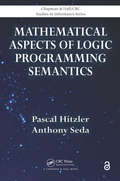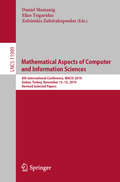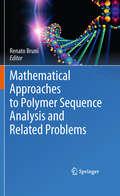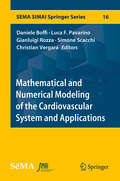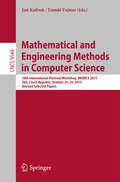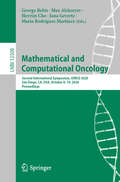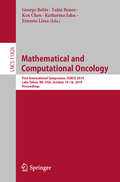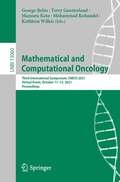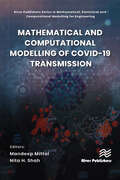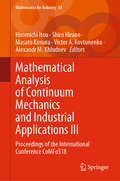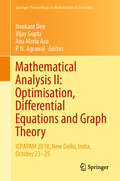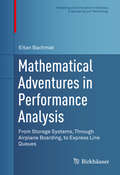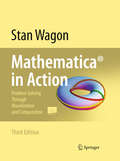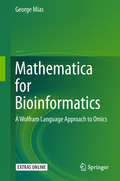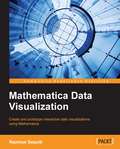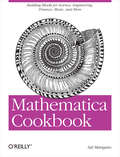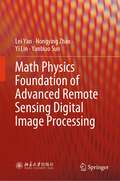- Table View
- List View
Mathematics Education in the Age of Artificial Intelligence: How Artificial Intelligence can Serve Mathematical Human Learning (Mathematics Education in the Digital Era #17)
by Philippe R. Richard M. Pilar Vélez Steven Van VaerenberghThis book highlights the contribution of artificial intelligence for mathematics education. It provides concrete ideas supported by mathematical work obtained through dynamic international collaboration, and discusses the flourishing of new mathematics in the contemporary world from a sustainable development perspective. Over the past thirty years, artificial intelligence has gradually infiltrated all facets of society. When it is deployed in interaction with the human designer or user, AI certainly raises new ethical questions. But as soon as it aims to augment intelligence in a kind of human-machine partnership, it goes to the heart of knowledge development and the very performance of work. The proposed themes and the sections of the book address original issues relating to the creation of AI milieus to work on mathematics, to the AI-supported learning of mathematics and to the coordination of « usual » paper/pencil techniques and « new » AI-aided educational working spaces. The authors of the book and the coordinators of each section are all established specialists in mathematics didactics, mathematics and computer science. In summary, this book is a must-read for everyone interested in the teaching and learning of mathematics, and it concerns the interaction between the human and the machine in both directions. It contains ideas, questions and inspiration that invite to take up the challenge of Artificial Intelligence contributing to Mathematical Human Learning.
Mathematics Education in Brazil: Panorama of Current Research
by Alessandro Jacques Ribeiro Lulu Healy Rute Elizabete Borba Solange Hassan FernandesThis book presents, for the first time in English, the state of the art of Mathematics Education research in Brazil, a country that has the strongest community in this field in Latin America. Edited by leading researchers in the area, the volume provides the international academic community a summary of the scientific production of the thirteen working groups of the Brazilian Society of Mathematics Education (SBEM), the national scientific society that brings together researchers, teachers, students and other professionals of the area. These working groups meet every three years at the International Seminar of Mathematics Education (SIPEM) and cover the following topics: Mathematics Education in the Early Years and Primary Education (Y1-Y5); Mathematics Education in the Middle School (Y6-Y9); Mathematics Education in the High School (Y10-Y12); Mathematics Education at the University level; History of Mathematics, Culture and Mathematics Education; Digital Technologies and Distance Education; Teacher Education; Assessment and Mathematics Education; Cognitive and Linguistic Processes in Mathematics Education; Mathematical Modeling; Philosophy of Mathematics Education, Teaching Probability and Statistics; and Difference, Inclusion and Mathematics Education. Each chapter of the book presents an overview of the production of a working group and they are all preceded by an introduction by professor Ubiratan D’Ambrosio, one of the pioneers of Mathematics Education in Brazil.
Mathematics Education and Technology-Rethinking the Terrain
by Celia Hoyles Jean-Baptiste LagrangeMathematics Education and Technology-Rethinking the Terrain revisits the important 1985 ICMI Study on the influence of computers and informatics on mathematics and its teaching. The focus of this book, resulting from the seventeenth Study led by ICMI, is the use of digital technologies in mathematics teaching and learning in countries across the world. Specifically, it focuses on cultural diversity and how this diversity impinges on the use of digital technologies in mathematics teaching and learning. Within this focus, themes such as mathematics and mathematical practices; learning and assessing mathematics with and through digital technologies; teachers and teaching; design of learning environments and curricula; implementation of curricula and classroom practice; access, equity and socio-cultural issues; and connectivity and virtual networks for learning, serve to organize the study and bring it coherence. Providing a state-of-the-art view of the domain with regards to research, innovating practices and technological development, Mathematics Education and Technology-Rethinking the Terrain is of interest to researchers and all those interested in the role that digital technology plays in mathematics education.
Mathematics and Technology
by Gilles Aldon Fernando Hitt Luciana Bazzini Uwe GellertThis volume collects most recent work on the role of technology in mathematics education. It offers fresh insight and understanding of the many ways in which technological resources can improve the teaching and learning of mathematics. The first section of the volume focuses on the question how a proposed mathematical task in a technological environment can influence the acquisition of knowledge and what elements are important to retain in the design of mathematical tasks in computing environments. The use of white smart boards, platforms as Moodle, tablets and smartphones have transformed the way we communicate both inside and outside the mathematics classroom. Therefore the second section discussed how to make efficient use of these resources in the classroom and beyond. The third section addresses how technology modifies the way information is transmitted and how mathematical education has to take into account the new ways of learning through connected networks as well as new ways of teaching. The last section is on the training of teachers in the digital era. The editors of this volume have selected papers from the proceedings of the 65th, 66th and 67th CIEAEM conference, and invited the correspondent authors to contribute to this volume by discussing one of the four important topics. The book continues a series of sourcebooks edited by CIEAEM, the Commission Internationale pour l'#65533;tude et l'Am#65533;lioration de l'Enseignement des Math#65533;matiques / International Commission for the Study and Improvement of Mathematics Education.
Mathematics and R Programming for Machine Learning: From the Ground Up
by William B. ClasterBased on the author’s experience in teaching data science for more than 10 years, Mathematics and Programming for Machine Learning with R: From the Ground Up reveals how machine learning algorithms do their magic and explains how these algorithms can be implemented in code. It is designed to provide readers with an understanding of the reasoning behind machine learning algorithms as well as how to program them. Written for novice programmers, the book progresses step-by-step, providing the coding skills needed to implement machine learning algorithms in R. The book begins with simple implementations and fundamental concepts of logic, sets, and probability before moving to the coverage of powerful deep learning algorithms. The first eight chapters deal with probability-based machine learning algorithms, and the last eight chapters deal with machine learning based on artificial neural networks. The first half of the book does not require mathematical sophistication, although familiarity with probability and statistics would be helpful. The second half assumes the reader is familiar with at least one semester of calculus. The text guides novice R programmers through algorithms and their application and along the way; the reader gains programming confidence in tackling advanced R programming challenges. Highlights of the book include: More than 400 exercises A strong emphasis on improving programming skills and guiding beginners to the implementation of full-fledged algorithms Coverage of fundamental computer and mathematical concepts including logic, sets, and probability In-depth explanations of machine learning algorithms
Mathematics and Modern Art
by Claude BruterThe link between mathematics and art remains as strong today as it was in the earliest instances of decorative and ritual art. Arts, architecture, music and painting have for a long time been sources of new developments in mathematics, and vice versa. Many great painters have seen no contradiction between artistic and mathematical endeavors, contributing to the progress of both, using mathematical principles to guide their visual creativity, enriching their visual environment with the new objects created by the mathematical science. Owing to the recent development of the so nice techniques for visualization, while mathematicians can better explore these new mathematical objects, artists can use them to emphasize their intrinsic beauty, and create quite new sceneries. This volume, the content of the first conference of the European Society for Mathematics and the Arts (ESMA), held in Paris in 2010, gives an overview on some significant and beautiful recent works where maths and art, including architecture and music, are interwoven. The book includes a wealth of mathematical illustrations from several basic mathematical fields including classical geometry, topology, differential geometry, dynamical systems. Here, artists and mathematicians alike elucidate the thought processes and the tools used to create their work
Mathematics and its Applications in New Computer Systems: MANCS-2021 (Lecture Notes in Networks and Systems #424)
by Andrei Tchernykh Anatoly Alikhanov Mikhail Babenko Irina SamoylenkoThis book is based on the best papers accepted for presentation during the International Conference on Mathematics and its Applications in New Computer Systems (MANCS-2021), Russia.The book includes research materials on modern mathematical problems, solutions in the field of cryptography, data analysis and modular computing, as well as scientific computing. The scope of numerical methods in scientific computing presents original research, including mathematical models and software implementations, related to the following topics: numerical methods in scientific computing; solving optimization problems; methods for approximating functions, etc. The studies in mathematical solutions to cryptography issues are devoted to secret sharing schemes, public key systems, private key systems, n-degree comparisons, modular arithmetic of simple, addition of points of an elliptic curve, Hasse theorem, homomorphic encryption and learning with error, and modifications of the RSA system. Furthermore, issues in data analysis and modular computing include contributions in the field of mathematical statistics, machine learning methods, deep learning, and neural networks. Finally, the book gives insights into the fundamental problems in mathematics education. The book intends for readership specializing in the field of cryptography, information security, parallel computing, computer technology, and mathematical education.
Mathematics and Computing: Icmc, Haldia, India, January 2015 (Springer Proceedings In Mathematics And Statistics Series #139)
by Debdas Ghosh Debasis Giri Ram N. Mohapatra Ekrem Savas Kouichi Sakurai L. P. SinghThis book constitutes the proceedings of the 4th International Conference on Mathematics and Computing, ICMC 2018, held in Varanasi, India, in January 2018.The 29 papers presented in this volume were carefully reviewed and selected from 116 submissions. They are organized in topical sections on security and coding theory; computing; applied mathematics; pure mathematics.
Mathematics and Computation in Music: 7th International Conference, MCM 2019, Madrid, Spain, June 18–21, 2019, Proceedings (Lecture Notes in Computer Science #11502)
by Mariana Montiel Francisco Gomez-Martin Octavio A. Agustín-AquinoThis book constitutes the thoroughly refereed proceedings of the 7th International Conference on Mathematics and Computation in Music, MCM 2019, held in Madrid, Spain, in June 2019. The 22 full papers and 10 short papers presented were carefully reviewed and selected from 48 submissions. The papers feature research that combines mathematics or computation with music theory, music analysis, composition, and performance. They are organized in topical sections on algebraic and other abstract mathematical approaches to understanding musical objects; remanaging Riemann: mathematical music theory as “experimental philosophy”?; octave division; computer-based approaches to composition and score structuring; models for music cognition and beat tracking; pedagogy of mathematical music theory.The chapter “Distant Neighbors and Interscalar Contiguities” is available open access under a Creative Commons Attribution 4.0 International License via link.springer.com.
Mathematics and Computation in Music: 8th International Conference, MCM 2022, Atlanta, GA, USA, June 21–24, 2022, Proceedings (Lecture Notes in Computer Science #13267)
by Mariana Montiel Octavio A. Agustín-Aquino Francisco Gómez Jeremy Kastine Emilio Lluis-Puebla Brent MilamThis book constitutes the thoroughly refereed proceedings of the 8th International Conference on Mathematics and Computation in Music, MCM 2022, held in Atlanta, GA, USA, in June 2022. The 29 full papers and 8 short papers presented were carefully reviewed and selected from 45 submissions. The papers feature research that combines mathematics or computation with music theory, music analysis, composition, and performance. They are organized in Mathematical Scale and Rhythm Theory: Combinatorial, Graph Theoretic, Group Theoretic and Transformational Approaches; Categorical and Algebraic Approaches to Music; Algorithms and Modeling for Music and Music-Related Phenomena; Applications of Mathematics to Musical Analysis; Mathematical Techniques and Microtonality
Mathematics and Computation in Music
by Anja Volk David Meredith Tom CollinsThis book constitutes the thoroughly refereed proceedings of the 5th International Conference on Mathematics and Computation in Music, MCM 2015, held in London, UK, in June 2015. The 24 full papers and 14 short papers presented were carefully reviewed and selected from 64 submissions. The papers feature research that combines mathematics or computation with music theory, music analysis, composition, and performance. They are organized in topical sections on notation and representation, music generation, patterns, performance, similarity and contrast, post-tonal music analysis, geometric approaches, deep learning, and scales.
Mathematical Transformations and Wavelet Filters for Source Coding and Signal Processing Systems (Synthesis Lectures on Signal Processing)
by William A. PearlmanThis book teaches the fundamentals and mathematical formulas of reversible transformations (or transforms) that are used in many source coding and signal processing systems. These mathematical transforms are often necessary or crucial toward reduction of data storage and transmission rate requirements. The author emphasizes the wavelet transform as it is the preferred transform for practical application in many coding and signal processing systems. The book also covers the tap (coefficient) values for some of those filters that satisfy the perfect reconstruction property. Examples of the use of filter-based and matrix-based transforms are also provided. This self-contained work contains insight gained through research and practice, which makes it a valuable reference and tutorial for readers interested in the subject of mathematical transforms.This book:Teaches the fundamentals and mathematical formulas of reversible transformations, as well as their applicationsHighlights the wavelet transformation, which is the preferred transform for many practical applicationsContains insight gained through research and practice, making it a valuable resource those interested in the topic
The Mathematical Tourist: New and Updated Snapshots of Modern Mathematics
by Ivars PetersonTo most outsiders, modern mathematics represents unknown territory. Few realize that the world of modern mathematics is rich with vivid images, provocative ideas, and useful notions. The revised, updated book also includes new material about the structure of crystals and about discoveries illuminating the relationship between four-dimensional geometry and physical theories of the nature of time, space, and matter. It adds the application of cellular automata models to social questions and to the peregrinations of virtual ants. It extends the discussion of applications of fractals and introduces the notion of controlling chaos. A greatly expanded concluding chapter on the nature of mathematical proof includes accounts of Turing machines, transparent proofs, and how a computer program managed to prove a long-standing mathematical conjecture. It ends with the dramatic unveiling of a proof by Andrew Wiles of Fermat's last theorem.
Mathematical Tools for Data Mining
by Dan A. Simovici Chabane DjerabaData mining essentially relies on several mathematical disciplines, many of which are presented in this second edition of this book. Topics include partially ordered sets, combinatorics, general topology, metric spaces, linear spaces, graph theory. To motivate the reader a significant number of applications of these mathematical tools are included ranging from association rules, clustering algorithms, classification, data constraints, logical data analysis, etc. The book is intended as a reference for researchers and graduate students. The current edition is a significant expansion of the first edition. We strived to make the book self-contained and only a general knowledge of mathematics is required. More than 700 exercises are included and they form an integral part of the material. Many exercises are in reality supplemental material and their solutions are included.
Mathematical Theory of Advanced Computing (It Kompakt Ser.)
by Wolfgang W. OsterhageThis book deals with computer performance by addressing basic preconditions. Besides general considerations about performance, several new approaches are presented. One of them targets memory structures by introducing the possibility of overlapping non-interfering (virtual) address spaces. This approach is based on a newly developed jump transformation between different symbol spaces. Another approach deals with efficiency and accuracy in scientific calculations. Finally the concept of a Neural Relational Data Base Management System is introduced and the performance potential of quantum computers assessed.
Mathematical Theories of Machine Learning - Theory and Applications
by Bin Shi S. S. IyengarThis book studies mathematical theories of machine learning. The first part of the book explores the optimality and adaptivity of choosing step sizes of gradient descent for escaping strict saddle points in non-convex optimization problems. In the second part, the authors propose algorithms to find local minima in nonconvex optimization and to obtain global minima in some degree from the Newton Second Law without friction. In the third part, the authors study the problem of subspace clustering with noisy and missing data, which is a problem well-motivated by practical applications data subject to stochastic Gaussian noise and/or incomplete data with uniformly missing entries. In the last part, the authors introduce an novel VAR model with Elastic-Net regularization and its equivalent Bayesian model allowing for both a stable sparsity and a group selection.
Mathematical Theories of Distributed Sensor Networks
by Sitharama S. Iyengar Kianoosh G. Boroojeni N. BalakrishnanThis book provides a Mathematical Theory of Distributed Sensor Networks. It introduces the Mathematical & Computational Structure by discussing what they are, their applications and how they differ from traditional systems. It also explains how mathematics are utilized to provide efficient techniques implementing effective coverage, deployment, transmission, data processing, signal processing, and data protection within distributed sensor networks. Finally, it discusses some important challenges facing mathematics to get more incite to the multidisciplinary area of distributed sensor networks. -This book will help design engineers to set up WSN-based applications providing better use of resources while optimizing processing costs. -This book is highly useful for graduate students starting their first steps in research to apprehend new approaches and understand the mathematics behind them and face promising challenges. -This book aims at presenting a formal framework allowing to show how mathematical theories can be used to provide distributed sensor modeling and to solve important problems such as coverage hole detection and repair. -This book aims at presenting the current state of the art in formal issues related to sensor networking. It can be used as a handbook for different classes at the graduate level and the undergraduate level. It is self contained and comprehensive, presenting a complete picture of the discipline of optical network engineering including modeling functions, controlling quality of service, allocation resources, monitoring traffic, protecting infrastructure, and conducting planning. This book addresses a large set of theoretical aspects. It is designed for specialists in ad hoc and wireless sensor networks and does not include discusses on very promising areas such as homotopy, computational geometry, and wavelet transforms.
Mathematical Summary for Digital Signal Processing Applications with Matlab
by E. S. GopiMathematical summary for Digital Signal Processing Applications with Matlab consists of Mathematics which is not usually dealt in the DSP core subject, but used in DSP applications. Matlab programs with illustrations are given for the selective topics such as generation of Multivariate Gaussian distributed sample outcomes, Bacterial foraging algorithm, Newton's iteration, Steepest descent algorithm, etc. are given exclusively in the separate chapter. Also Mathematical summary for Digital Signal Processing Applications with Matlab is written in such a way that it is suitable for Non-Mathematical readers and is very much suitable for the beginners who are doing research in Digital Signal Processing.
Mathematical Structures of Ergodicity and Chaos in Population Dynamics (Studies in Systems, Decision and Control #312)
by Paweł J. MitkowskiThis book concerns issues related to biomathematics, medicine, or cybernetics as practiced by engineers. Considered population dynamics models are still in the interest of researchers, and even this interest is increasing, especially now in the time of SARS-CoV-2 coronavirus pandemic, when models are intensively studied in order to help predict its behaviour within human population. The structures of population dynamics models and practical methods of finding their solutions are discussed. Finally, the hypothesis of the existence of non-trivial ergodic properties of the model of erythropoietic response dynamics formulated by A. Lasota in the form of delay differential equation with unimodal feedback is analysed. The research can be compared with actual medical data, as well as shows that the structures of population models can reflect the dynamic structures of reality.
Mathematical Structures for Computer Graphics
by Steven J. JankeA comprehensive exploration of the mathematics behind the modeling and rendering of computer graphics scenesMathematical Structures for Computer Graphics presents an accessible and intuitive approach to the mathematical ideas and techniques necessary for two- and three-dimensional computer graphics. Focusing on the significant mathematical results, the book establishes key algorithms used to build complex graphics scenes.Written for readers with various levels of mathematical background, the book develops a solid foundation for graphics techniques and fills in relevant graphics details often overlooked in the literature. Rather than use a rigid theorem/proof approach, the book provides a flexible discussion that moves from vector geometry through transformations, curve modeling, visibility, and lighting models. Mathematical Structures for Computer Graphics also includes:Numerous examples of two- and three-dimensional techniques along with numerical calculationsPlenty of mathematical and programming exercises in each chapter, which are designed particularly for graphics tasksAdditional details at the end of each chapter covering historical notes, further calculations, and connected concepts for readers who wish to delve deeperUnique coverage of topics such as calculations with homogeneous coordinates, computational geometry for polygons, use of barycentric coordinates, various descriptions for curves, and L-system techniques for recursive imagesMathematical Structures for Computer Graphics is an excellent textbook for undergraduate courses in computer science, mathematics, and engineering, as well as an ideal reference for practicing engineers, researchers, and professionals in computer graphics fields. The book is also useful for those readers who wish to understand algorithms for producing their own interesting computer images.
Mathematical-Statistical Models and Qualitative Theories for Economic and Social Sciences
by Janusz Kacprzyk Fabrizio Maturo Šárka Hošková-MayerováThis book presents a broad spectrum of problems related to statistics, mathematics, teaching, social science, and economics as well as a range of tools and techniques that can be used to solve these problems. It is the result of a scientific collaboration between experts in the field of economic and social systems from the University of Defence in Brno (Czech Republic), G. d'Annunzio University of Chieti-Pescara (Italy), Pablo de Olavid eUniversity of Sevilla (Spain), and Ovidius University in Constanţa, (Romania). The studies included were selected using a peer-review process and reflect heterogeneity and complexity of economic and social phenomena. They and present interesting empirical research from around the globe and from several research fields, such as statistics, decision making, mathematics, complexity, psychology, sociology and economics. The volume is divided into two parts. The first part, "Recent trends in mathematical and statistical models for economic and social sciences", collects papers on quantitative matters, which propose mathematical and statistical models for social sciences, economics, finance, and business administration. The second part, "Recent trends in qualitative theories for economic and social sciences", includes papers on qualitative matters, which discuss social, economic, and teaching issues. It is an ideal reference work for all those researchers interested in recent quantitative and qualitative tools. Covering a wide range of topics, it appeals in equal measure to mathematicians, statisticians, sociologists, philosophers, and specialists in the fields of communication, social and political sciences.
Mathematical Software - ICMS 2016
by Gert-Martin Greuel Thorsten Koch Peter Paule Andrew SommeseThis book constitutes the proceedings of the 5th International Conference on Mathematical Software, ICMS 2015, held in Berlin, Germany, in July 2016. The 68 papers included in this volume were carefully reviewed and selected from numerous submissions. The papers are organized in topical sections named: univalent foundations and proof assistants; software for mathematical reasoning and applications; algebraic and toric geometry; algebraic geometry in applications; software of polynomial systems; software for numerically solving polynomial systems; high-precision arithmetic, effective analysis, and special functions; mathematical optimization; interactive operation to scientific artwork and mathematical reasoning; information services for mathematics: software, services, models, and data; semDML: towards a semantic layer of a world digital mathematical library; miscellanea.
Mathematical Software – ICMS 2020: 7th International Conference, Braunschweig, Germany, July 13–16, 2020, Proceedings (Lecture Notes in Computer Science #12097)
by Anna Maria Bigatti Jacques Carette James H. Davenport Michael Joswig Timo De WolffThis book constitutes the proceedings of the 7th International Conference on Mathematical Software, ICMS 2020, held in Braunschweig, Germany, in July 2020. The 48 papers included in this volume were carefully reviewed and selected from 58 submissions. The program of the 2020 meeting consisted of 20 topical sessions, each of which providing an overview of the challenges, achievements and progress in a environment of mathematical software research, development and use.
Mathematical Software – ICMS 2018: 6th International Conference, South Bend, IN, USA, July 24-27, 2018, Proceedings (Lecture Notes in Computer Science #10931)
by James H. Davenport Manuel Kauers George Labahn Josef UrbanThis book constitutes the proceedings of the 6th International Conference on Mathematical Software, ICMS 2018, held in South Bend, IN, USA, in July 2018.The 59 papers included in this volume were carefully reviewed and selected from numerous submissions. The program of the 2018 meeting consisted of 20 topical sessions, each of which providing an overview of the challenges, achievements and progress in a subeld of mathematical software research, development and use.
Mathematical Research for Blockchain Economy: 1st International Conference MARBLE 2019, Santorini, Greece (Springer Proceedings in Business and Economics)
by Panos Pardalos Ilias Kotsireas William Knottenbelt Yike GuoThis book presents the best papers from the 1st International Conference on Mathematical Research for Blockchain Economy (MARBLE) 2019, held in Santorini, Greece. While most blockchain conferences and forums are dedicated to business applications, product development or Initial Coin Offering (ICO) launches, this conference focused on the mathematics behind blockchain to bridge the gap between practice and theory. Every year, thousands of blockchain projects are launched and circulated in the market, and there is a tremendous wealth of blockchain applications, from finance to healthcare, education, media, logistics and more. However, due to theoretical and technical barriers, most of these applications are impractical for use in a real-world business context. The papers in this book reveal the challenges and limitations, such as scalability, latency, privacy and security, and showcase solutions and developments to overcome them.
Mathematical Research for Blockchain Economy: 4th International Conference MARBLE 2023, London, United Kingdom (Lecture Notes in Operations Research)
by Panos Pardalos Ilias Kotsireas William J. Knottenbelt Stefanos LeonardosThis book presents the best papers from the 4th International Conference on Mathematical Research for Blockchain Economy (MARBLE) 2023, held in London, UK. While most blockchain conferences and forums are dedicated to business applications, product development, or Initial Coin Offering (ICO) launches, this conference focused on the mathematics behind blockchain to bridge the gap between practice and theory. The book spans the divide between theoretical promise and practical reality in blockchain technology and explores the challenges hindering its real-world integration across diverse sectors, offering comprehensive insights into issues like scalability, security, and privacy.
Mathematical Reasoning: The History and Impact of the DReaM Group
by Greg MichaelsonThis collection of essays examines the key achievements and likely developments in the area of automated reasoning. In keeping with the group ethos, Automated Reasoning is interpreted liberally, spanning underpinning theory, tools for reasoning, argumentation, explanation, computational creativity, and pedagogy. Wider applications including secure and trustworthy software, and health care and emergency management. The book starts with a technically oriented history of the Edinburgh Automated Reasoning Group, written by Alan Bundy, which is followed by chapters from leading researchers associated with the group. Mathematical Reasoning: The History and Impact of the DReaM Group will attract considerable interest from researchers and practitioners of Automated Reasoning, including postgraduates. It should also be of interest to those researching the history of AI.
Mathematical Progress in Expressive Image Synthesis III
by Yoshinori Dobashi Hiroyuki Ochiai"Progress in Expressive Image Synthesis"(MEIS2015), was held in Fukuoka, Japan, September 25-27, 2015. The aim of thesymposium was to provide a unique venue where various issues in computergraphics (CG) application fields could be discussed by mathematicians, CGresearchers, and practitioners. Through the previous symposiums MEIS2013 andMEIS2014, mathematicians as well as CG researchers have recognized that CG is aspecific and practical activity derived from mathematical theories. Issuesfound in CG broaden the field of mathematics and vice versa, and CG visualizesmathematical theories in an aesthetic manner. In this volume, the editors aim toprovoke interdisciplinary research projects through the peer-reviewed papersand poster presentations at the this year's symposium. This book capturesinteractions among mathematicians, CG researchers, and practitioners sharingimportant, state-of-the-art issues in graphics and visual perception. The bookis suitable for all CG researchers seeking open problem areas and especiallyfor those entering the field who have not yet selected a research direction.
Mathematical Progress in Expressive Image Synthesis II
by Hiroyuki Ochiai Ken AnjyoThe material included in this book provides selected presentations given at the international symposium MEIS2014. The book aims to provide a unique venue where various issues in computer graphics (CG) application fields are discussed by mathematicians as well as CG researchers and practitioners. The target audience is not limited to researchers in academia but also those in industries with a strong interest in digital media creation, scientific visualization and visual engineering.
Mathematical Progress in Expressive Image Synthesis I
by Ken AnjyoThis book presents revised versions of the best papers selected from the symposium "Mathematical Progress in Expressive Image Synthesis" (MEIS2013) held in Fukuoka, Japan, in 2013. The topics cover various areas of computer graphics (CG), such as surface deformation/editing, character animation, visual simulation of fluids, texture and sound synthesis and photorealistic rendering. From a mathematical point of view, the book also presents papers addressing discrete differential geometry, Lie theory, computational fluid dynamics, function interpolation and learning theory. This book showcases the latest joint efforts between mathematicians, CG researchers and practitioners exploring important issues in graphics and visual perception. The book provides a valuable resource for all computer graphics researchers seeking open problem areas, especially those now entering the field who have not yet selected a research direction.
Mathematical Programming Solver Based on Local Search
by Frédéric Gardi Thierry Benoist Julien Darlay Bertrand Estellon Romain MegelThis book covers local search for combinatorial optimization and its extension to mixed-variable optimization. Although not yet understood from the theoretical point of view, local search is the paradigm of choice for tackling large-scale real-life optimization problems. Today's end-users demand interactivity with decision support systems. For optimization software, this means obtaining good-quality solutions quickly. Fast iterative improvement methods, like local search, are suited to satisfying such needs. Here the authors show local search in a new light, in particular presenting a new kind of mathematical programming solver, namely LocalSolver, based on neighborhood search. First, an iconoclast methodology is presented to design and engineer local search algorithms. The authors' concern regarding industrializing local search approaches is of particular interest for practitioners. This methodology is applied to solve two industrial problems with high economic stakes. Software based on local search induces extra costs in development and maintenance in comparison with the direct use of mixed-integer linear programming solvers. The authors then move on to present the LocalSolver project whose goal is to offer the power of local search through a model-and-run solver for large-scale 0-1 nonlinear programming. They conclude by presenting their ongoing and future work on LocalSolver toward a full mathematical programming solver based on local search.
Mathematical Programming Methods for Geographers and Planners (Routledge Revivals)
by James KillenOriginally published in 1983, this was the first text to offer an in-depth treatment of mathematical programming methods explained from first principles. It considers all the major programming techniques and fully explains key terms, illustrates theories with detailed examples and shows how the various skills are applied in practice. It will be invaluable in both the academic world and to policy formulators and planners, who make extensive use of the methods described.
Mathematical Programming for Operations Researchers and Computer Scientists
by Albert G. HolzmanThis book covers the fundamentals of linear programming, extension of linear programming to discrete optimization methods, multi-objective functions, quadratic programming, geometric programming, and classical calculus methods for solving nonlinear programming problems.
Mathematical Programming and Game Theory (Indian Statistical Institute Series)
by S. K. Neogy Ravindra B. Bapat Dipti DubeyThis book discusses recent developments in mathematical programming and game theory, and the application of several mathematical models to problems in finance, games, economics and graph theory. All contributing authors are eminent researchers in their respective fields, from across the world. This book contains a collection of selected papers presented at the 2017 Symposium on Mathematical Programming and Game Theory at New Delhi during 9–11 January 2017. Researchers, professionals and graduate students will find the book an essential resource for current work in mathematical programming, game theory and their applications in finance, economics and graph theory. The symposium provides a forum for new developments and applications of mathematical programming and game theory as well as an excellent opportunity to disseminate the latest major achievements and to explore new directions and perspectives.
Mathematical Principles of the Internet, Volume 2: Mathematics (Chapman & Hall/CRC Computer and Information Science Series)
by Nirdosh BhatnagarThis two-volume set on Mathematical Principles of the Internet provides a comprehensive overview of the mathematical principles of Internet engineering. The books do not aim to provide all of the mathematical foundations upon which the Internet is based. Instead, they cover a partial panorama and the key principles. Volume 1 explores Internet engineering, while the supporting mathematics is covered in Volume 2. The chapters on mathematics complement those on the engineering episodes, and an effort has been made to make this work succinct, yet self-contained. Elements of information theory, algebraic coding theory, cryptography, Internet traffic, dynamics and control of Internet congestion, and queueing theory are discussed. In addition, stochastic networks, graph-theoretic algorithms, application of game theory to the Internet, Internet economics, data mining and knowledge discovery, and quantum computation, communication, and cryptography are also discussed. In order to study the structure and function of the Internet, only a basic knowledge of number theory, abstract algebra, matrices and determinants, graph theory, geometry, analysis, optimization theory, probability theory, and stochastic processes, is required. These mathematical disciplines are defined and developed in the books to the extent that is needed to develop and justify their application to Internet engineering.
Mathematical Principles of the Internet, Volume 1: Engineering (Chapman & Hall/CRC Computer and Information Science Series)
by Nirdosh BhatnagarThis two-volume set on Mathematical Principles of the Internet provides a comprehensive overview of the mathematical principles of Internet engineering. The books do not aim to provide all of the mathematical foundations upon which the Internet is based. Instead, they cover a partial panorama and the key principles. Volume 1 explores Internet engineering, while the supporting mathematics is covered in Volume 2. The chapters on mathematics complement those on the engineering episodes, and an effort has been made to make this work succinct, yet self-contained. Elements of information theory, algebraic coding theory, cryptography, Internet traffic, dynamics and control of Internet congestion, and queueing theory are discussed. In addition, stochastic networks, graph-theoretic algorithms, application of game theory to the Internet, Internet economics, data mining and knowledge discovery, and quantum computation, communication, and cryptography are also discussed. In order to study the structure and function of the Internet, only a basic knowledge of number theory, abstract algebra, matrices and determinants, graph theory, geometry, analysis, optimization theory, probability theory, and stochastic processes, is required. These mathematical disciplines are defined and developed in the books to the extent that is needed to develop and justify their application to Internet engineering.
Mathematical Principles of Human Conceptual Behavior: The Structural Nature of Conceptual Representation and Processing (Scientific Psychology Series)
by Ronaldo VigoThe ability to learn concepts lies at the very core of human cognition, enabling us to efficiently classify, organize, identify, and store complex information. In view of the basic role that concepts play in our everyday physical and mental lives, the fields of cognitive science and psychology face three long standing challenges: discovering the laws that govern concept learning and categorization behavior in organisms, showing how they inform other areas of cognitive research, and describing them with the mathematical systematicity and precision found in the physical sciences. In light of these theoretical and methodological shortcomings, this volume will introduce a set of general mathematical principles for predicting and explaining conceptual behavior. The author’s theory is based on seven fundamental constructs of universal science: invariance, complexity, information, similarity, dissimilarity, pattern, and representation. These constructs are joined by a novel mathematical framework that does not depend on probability theory, and derives key results from conceptual behavior research with other key areas of cognitive research such as pattern perception, similarity assessment, and contextual choice. The result is a unique and systematic unifying foundation for cognitive science in the tradition of classical physics.
Mathematical Optimization Theory and Operations Research: 18th International Conference, MOTOR 2019, Ekaterinburg, Russia, July 8 - 12, 2019, Revised Selected Papers (Communications in Computer and Information Science #1090)
by Igor Bykadorov Vitaly Strusevich Tatiana TchemisovaThis book constitutes revised and selected papers from the 18th International Conference on Mathematical Optimization Theory and Operations Research, MOTOR 2019, held in Ekaterinburg, Russia, in July 2019. The 40 full papers and 4 short papers presented in this volume were carefully reviewed and selected from a total of 170 submissions. The papers in the volume are organised according to the following topical headings: combinatorial optimization; game theory and mathematical economics; data mining and computational geometry; integer programming; mathematical programming; operations research; optimal control and applications.
Mathematical Optimization Theory and Operations Research: 22nd International Conference, MOTOR 2023, Ekaterinburg, Russia, July 2–8, 2023, Revised Selected Papers (Communications in Computer and Information Science #1881)
by Michael Khachay Yury Kochetov Anton Eremeev Oleg Khamisov Vladimir Mazalov Panos PardalosThis book constitutes refereed proceedings of the 22nd International Conference on Mathematical Optimization Theory and Operations Research: Recent Trends, MOTOR 2023, held in Ekaterinburg, Russia, during July 2–8, 2023. The 28 full papers and one invited paper presented in this volume were carefully reviewed and selected from a total of 61 submissions. The papers in the volume are organized according to the following topical headings: mathematical programming; stochastic optimization; discrete and combinatorial optimization; operations research; optimal control and mathematical economics; and optimization in machine learning.
Mathematical Optimization Theory and Operations Research: 18th International Conference, MOTOR 2019, Ekaterinburg, Russia, July 8-12, 2019, Proceedings (Lecture Notes in Computer Science #11548)
by Michael Khachay Yury Kochetov Panos PardalosThis book constitutes the proceedings of the 18th International Conference on Mathematical Optimization Theory and Operations Research, MOTOR 2019, held in Ekaterinburg, Russia, in July 2019.The 48 full papers presented in this volume were carefully reviewed and selected from 170 submissions. MOTOR 2019 is a successor of the well-known International and All-Russian conference series, which were organized in Ural, Siberia, and the Far East for a long time. The selected papers are organized in the following topical sections: mathematical programming; bi-level optimization; integer programming; combinatorial optimization; optimal control and approximation; data mining and computational geometry; games and mathematical economics.
Mathematical Optimization Theory and Operations Research: 19th International Conference, MOTOR 2020, Novosibirsk, Russia, July 6–10, 2020, Revised Selected Papers (Communications in Computer and Information Science #1275)
by Yury Kochetov Igor Bykadorov Tatiana GruzdevaThis book constitutes refereed proceedings of the 19th International Conference on Mathematical Optimization Theory and Operations Research, MOTOR 2020, held in July 2020. Due to the COVID-19 pandemic the conference was held online. The 25 full papers and 8 short papers presented in this volume were carefully reviewed and selected from a total of 102 submissions. The papers in the volume are organised according to the following topical headings: combinatorial optimization; mathematical programming; global optimization; game theory and mathematical economics; heuristics and metaheuristics; machine learning and data analysis.
Mathematical Optimization Theory and Operations Research: 19th International Conference, MOTOR 2020, Novosibirsk, Russia, July 6–10, 2020, Proceedings (Lecture Notes in Computer Science #12095)
by Alexander Kononov Michael Khachay Valery A Kalyagin Panos PardalosThis book constitutes the proceedings of the 19th International Conference on Mathematical Optimization Theory and Operations Research, MOTOR 2020, held in Novosibirsk, Russia, in July 2020. The 31 full papers presented in this volume were carefully reviewed and selected from 102 submissions. The papers are grouped in these topical sections: discrete optimization; mathematical programming; game theory; scheduling problem; heuristics and metaheuristics; and operational research applications.
Mathematical Optimization Theory and Operations Research: 20th International Conference, MOTOR 2021, Irkutsk, Russia, July 5–10, 2021, Proceedings (Lecture Notes in Computer Science #12755)
by Panos Pardalos Michael Khachay Alexander KazakovThis book constitutes the proceedings of the 20th International Conference on Mathematical Optimization Theory and Operations Research, MOTOR 2021, held in Irkutsk, Russia, in July 2021. The 29 full papers and 1 short paper presented in this volume were carefully reviewed and selected from 102 submissions. Additionally, 2 full invited papers are presented in the volume. The papers are grouped in the following topical sections: combinatorial optimization; mathematical programming; bilevel optimization; scheduling problems; game theory and optimal control; operational research and mathematical economics; data analysis.
Mathematical Morphology and Its Applications to Signal and Image Processing: 14th International Symposium, ISMM 2019, Saarbrücken, Germany, July 8-10, 2019, Proceedings (Lecture Notes in Computer Science #11564)
by Bernhard Burgeth Andreas Kleefeld Benoît Naegel Nicolas Passat Benjamin PerretThis book contains the refereed proceedings of the 14th International Symposium on Mathematical Morphology, ISMM 2019, held in Saarbrücken, Germany, in July 2019. The 40 revised full papers presented together with one invited talk were carefully reviewed and selected from 54 submissions. The papers are organized in topical sections on Theory, Discrete Topology and Tomography, Trees and Hierarchies, Multivariate Morphology, Computational Morphology, Machine Learning, Segmentation, Applications in Engineering, and Applications in (Bio)medical Imaging.
Mathematical Morphology and Its Applications to Signal and Image Processing: 13th International Symposium, ISMM 2017, Fontainebleau, France, May 15–17, 2017, Proceedings (Lecture Notes in Computer Science #10225)
by Jesús Angulo, Santiago Velasco-Forero and Fernand MeyerThis book contains the refereed proceedings of the 13th International Symposium on Mathematical Morphology, ISMM 2017, held in Fontainebleau, France, in May 2017. The 36 revised full papers presented together with 4 short papers were carefully reviewed and selected from 53 submissions. The papers are organized in topical sections on algebraic theory, max-plus and max-min mathematics; discrete geometry and discrete topology; watershed and graph-based segmentation; trees and hierarchies; topological and graph-based clustering, classification and filtering; connected operators and attribute filters; PDE-based morphology; scale-space representations and nonlinear decompositions; computational morphology; object detection; and biomedical, material science and physical applications.
Mathematical Models for Evacuation Planning in Urban Areas
by Sarah BretschneiderDisasters like floods, hurricanes, chemical or nuclear accidents may cause the necessity to evacuate the affected area. The evacuation of the urban area needs to be planned carefully. One issue is the reorganization of the traffic routing. Congested urban areas have usually complex street networks that are composed of many intersections with streets connecting them. The population density of a congested urban area is usually high and the street network is already used to capacity during rush hour traffic. The considered problem of this work is the reorganization of the traffic routing of an urban area for the case of an emergency mass evacuation. Especially aspects of the evacuation like safety, avoidance of delays and the total system travel time are taken into account. Combinatorial and graph theoretical aspects are adapted for the evacuation problem and highlight issues concerning especially conflicts within intersections. This work gives an extensive summary of literature of evacuation of urban areas. Mixed-integer linear programming models are developed for evacuation problems and heuristic algorithms are provided and tested.?
Mathematical Modelling of Decision Problems: Using the SIMUS Method for Complex Scenarios (Multiple Criteria Decision Making)
by Nolberto MunierThis book is intended as a guide to and manual on modeling complex problems in Multi Criteria Decision Making (MCDM). It encourages practitioners to consider the practicalities of real-world scenarios when modeling, while at the same time providing tips and examples of how to incorporate these realities into the initial decision matrix. The goal is to help readers build a decision matrix that replicates reality as closely as possible. Once this matrix has been constructed, the Decision Maker (DM) can select from more than a hundred MCDM methods the one that best fits the requirements and conditions of the matrix. The book features cases taken from real-world scenarios, which deal with various fields, aspects, and characteristics, and are solved using the SIMUS (Sequential Interactive Modeling for Urban Systems) method. This book is a valuable tool for practitioners, researchers and students dealing with MCDM problems.
Mathematical Modelling in Plant Biology
by Richard J. MorrisProgress in plant biology relies on the quantification, analysis and mathematical modeling of data over different time and length scales. This book describes common mathematical and computational approaches as well as some carefully chosen case studies that demonstrate the use of these techniques to solve problems at the forefront of plant biology. Each chapter is written by an expert in field with the goal of conveying concepts whilst at the same time providing sufficient background and links to available software for readers to rapidly build their own models and run their own simulations. This book is aimed at postgraduate students and researchers working the field of plant systems biology and synthetic biology, but will also be a useful reference for anyone wanting to get into quantitative plant biology.
Mathematical Modelling in Health, Social and Applied Sciences (Forum for Interdisciplinary Mathematics)
by Hemen DuttaThis book discusses significant research findings in the field of mathematical modelling, with particular emphasis on important applied-sciences, health, and social issues. It includes topics such as model on viral immunology, stochastic models for the dynamics of influenza, model describing the transmission of dengue, model for human papillomavirus (HPV) infection, prostate cancer model, realization of economic growth by goal programming, modelling of grazing periodic solutions in discontinuous systems, modelling of predation system, fractional epidemiological model for computer viruses, and nonlinear ecological models. A unique addition in the proposed areas of research and education, this book is a valuable resource for graduate students, researchers and educators associated with the study of mathematical modelling of health, social and applied-sciences issues. Readers interested in applied mathematics should also find this book valuable.
Mathematical Modelling, Applied Analysis and Computation: ICMMAAC 2018, Jaipur, India, July 6-8 (Springer Proceedings in Mathematics & Statistics #272)
by Jagdev Singh Devendra Kumar Hemen Dutta Dumitru Baleanu Sunil Dutt PurohitThis book contains original research papers presented at the International Conference on Mathematical Modelling, Applied Analysis and Computation, held at JECRC University, Jaipur, India, on 6-8 July, 2018. Organized into 20 chapters, the book focuses on theoretical and applied aspects of various types of mathematical modelling such as equations of various types, fuzzy mathematical models, automata, Petri nets and bond graphs for systems of dynamic nature and the usage of numerical techniques in handling modern problems of science, engineering and finance. It covers the applications of mathematical modelling in physics, chemistry, biology, mechanical engineering, civil engineering, computer science, social science and finance. A wide variety of dynamical systems like deterministic, stochastic, continuous, discrete or hybrid, with respect to time, are discussed in the book. It provides the mathematical modelling of various problems arising in science and engineering, and also new efficient numerical approaches for solving linear and nonlinear problems and rigorous mathematical theories, which can be used to analyze a different kind of mathematical models. The conference was aimed at fostering cooperation among students and researchers in areas of applied analysis, engineering and computation with the deliberations to inculcate new research ideas in their relevant fields. This volume will provide a comprehensive introduction to recent theories and applications of mathematical modelling and numerical simulation, which will be a valuable resource for graduate students and researchers of mathematical modelling and industrial mathematics.
Mathematical Modelling and Scientific Computing with Applications: ICMMSC 2018, Indore, India, July 19–21 (Springer Proceedings in Mathematics & Statistics #308)
by Santanu Manna Biswa Nath Datta Sk. Safique AhmadThis book contains original research papers presented at the International Conference on Mathematical Modelling and Scientific Computing, held at the Indian Institute of Technology Indore, India, on 19–21 July 2018. Organized into 30 chapters, the book presents the recent progress and the most advanced innovations, trends, and real-world challenges encountered and solutions embraced in the applications of mathematics and scientific computing. The book will be of interests to a wide variety of researchers, students and the practicing engineers working in diverse areas of science and engineering, ranging from applied and computational mathematics, vibration problem, computer science, and numerical optimization to physics, chemistry, biology, electrical, civil, mechanical, chemical, seismology, aerospace, and medical sciences. The aim of the conference is to bring together leading academicians, scientists, researchers, engineers, and industry partners from all over the globe to exchange and share their experiences and research results on various aspects of applied mathematics and scientific computation, like, differential equation, modeling, simulation, dynamical systems, numerical analysis, matrix theory, inverse problems, and solid and fluid mechanics, computational engineering.
Mathematical Modelling and Optimization of Engineering Problems (Nonlinear Systems and Complexity #30)
by Dumitru Baleanu J. A. Tenreiro Machado Necati ÖzdemirThis book presents recent developments in modelling and optimization of engineering systems and the use of advanced mathematical methods for solving complex real-world problems. It provides recent theoretical developments and new techniques based on control, optimization theory, mathematical modeling and fractional calculus that can be used to model and understand complex behavior in natural phenomena including latest technologies such as additive manufacturing. Specific topics covered in detail include combinatorial optimization, flow and heat transfer, mathematical modelling, energy storage and management policy, artificial intelligence, optimal control, modelling and optimization of manufacturing systems.
Mathematical Modeling of Social Relationships: What Mathematics Can Tell Us About People (Computational Social Sciences)
by Urszula Strawinska-Zanko Larry S. LiebovitchThis edited volume presents examples of social science research projects that employ new methods of quantitative analysis and mathematical modeling of social processes. This book presents the fascinating areas of empirical and theoretical investigations that use formal mathematics in a way that is accessible for individuals lacking extensive expertise but still desiring to expand their scope of research methodology and add to their data analysis toolbox. Mathematical Modeling of Social Relationships professes how mathematical modeling can help us understand the fundamental, compelling, and yet sometimes complicated concepts that arise in the social sciences. This volume will appeal to upper-level students and researchers in a broad area of fields within the social sciences, as well as the disciplines of social psychology, complex systems, and applied mathematics.
Mathematical Modeling of Biosensors
by Juozas Kulys Romas Baronas Feliksas IvanauskasThis book presents biosensor development and modeling from both a chemical and a mathematical point of view. It contains unique modeling methods for catalytical (amperometric, potentiometer and optical) biosensors. It examines processes that occur in the sensors' layers and at their interface, and it provides analytical and numerical methods to solve enzymatic kinetic and diffusion equations. The action of single enzyme as well as polyenzyme biosensors is studied, and the modeling of biosensors that contain perforated membranes and multipart mass transport profiles is critically investigated. Furthermore, it is fully described how signals can be biochemically amplified, how cascades of enzymatic substrate conversion are triggered, and how signals are processed via a chemometric approach and artificial neuronal networks. The results of digital modeling are compared with both proximal analytical solutions and experimental data.
Mathematical Modeling in Mechanics of Granular Materials
by Holm Altenbach Oxana Sadovskaya Vladimir SadovskiiThis monograph contains original results in the field of mathematical and numerical modeling of mechanical behavior of granular materials and materials with different strengths. It proposes new models helping to define zones of the strain localization. The book shows how to analyze processes of the propagation of elastic and elastic-plastic waves in loosened materials, and constructs models of mixed type, describing the flow of granular materials in the presence of quasi-static deformation zones. In a last part, the book studies a numerical realization of the models on multiprocessor computer systems. The book is intended for scientific researchers, lecturers of universities, post-graduates and senior students, who specialize in the field of the deformable materials mechanics, mathematical modeling and adjacent fields of applied and calculus mathematics.
Mathematical Modeling for Intelligent Systems: Theory, Methods, and Simulation
by Mukesh Kumar AwasthiMathematical Modeling for Intelligent Systems: Theory, Methods, and Simulation aims to provide a reference for the applications of mathematical modeling using intelligent techniques in various unique industry problems in the era of Industry 4.0. Providing a thorough introduction to the field of soft-computing techniques, this book covers every major technique in artificial intelligence in a clear and practical style. It also highlights current research and applications, addresses issues encountered in the development of applied systems, and describes a wide range of intelligent systems techniques, including neural networks, fuzzy logic, evolutionary strategy, and genetic algorithms. This book demonstrates concepts through simulation examples and practical experimental results. Key Features: • Offers a well-balanced mathematical analysis of modeling physical systems • Summarizes basic principles in differential geometry and convex analysis as needed • Covers a wide range of industrial and social applications and bridges the gap between core theory and costly experiments through simulations and modeling • Focuses on manifold ranging from stability of fluid flows, nanofluids, drug delivery, and security of image data to pandemic modeling, etc. This book is primarily aimed at advanced undergraduates and postgraduate students studying computer science, mathematics, and statistics. Researchers and professionals will also find this book useful.
Mathematical Modeling for Genes to Collective Cell Dynamics (Theoretical Biology)
by Tetsuji TokihiroThis book describes the dynamics of biological cells and their mathematical modeling. The topics cover the dynamics of RNA polymerases in transcription, construction of vascular networks in angiogenesis, and synchronization of cardiomyocytes. Statistical analysis of single cell dynamics and classification of proteins by mathematical modeling are also presented. The book provides the most up-to-date information on both experimental results and mathematical models that can be used to analyze cellular dynamics. Novel experimental results and approaches to understand them will be appealing to the readers. Each chapter contains 1) an introductory description of the phenomenon, 2) explanations about the mathematical technique to analyze it, 3) new experimental results, 4) mathematical modeling and its application to the phenomenon. Elementary introductions for the biological phenomenon and mathematical approach to them are especially useful for beginners. The importance of collaboration between mathematics and biological sciences has been increasing and providing new outcomes. This book gives good examples of the fruitful collaboration between mathematics and biological sciences.
Mathematical Modeling for Complex Fluids and Flows
by Michel Deville Thomas B. GatskiMathematical Modeling for Complex Fluids and Flows provides researchers and engineering practitioners encountering fluid flows with state-of-the-art knowledge in continuum concepts and associated fluid dynamics. In doing so it supplies the means to design mathematical models of these flows that adequately express the engineering physics involved. It exploits the implicit link between the turbulent flow of classical Newtonian fluids and the laminar and turbulent flow of non-Newtonian fluids such as those required in food processing and polymeric flows. The book develops a descriptive mathematical model articulated through continuum mechanics concepts for these non-Newtonian, viscoelastic fluids and turbulent flows. Each complex fluid and flow is examined in this continuum context as well as in combination with the turbulent flow of viscoelastic fluids. Some details are also explored via kinetic theory, especially viscoelastic fluids and their treatment with the Boltzmann equation. Both solution and modeling strategies for turbulent flows are laid out using continuum concepts, including a description of constructing polynomial representations and accounting for non-inertial and curvature effects. Ranging from fundamental concepts to practical methodology, and including discussion of emerging technologies, this book is ideal for those requiring a single-source assessment of current practice in this intricate yet vital field.
Mathematical Modeling, Computational Intelligence Techniques and Renewable Energy: Proceedings of the Third International Conference, MMCITRE 2022 (Advances in Intelligent Systems and Computing #1440)
by Manoj Sahni José M. Merigó Walayat Hussain Ernesto León-Castro Raj Kumar Verma Ritu SahniThe book is a collection of best selected research papers presented at the Third International Conference on “Mathematical Modeling, Computational Intelligence Techniques and Renewable Energy (MMCITRE 2022),” organized by the University of Technology Sydney, Australia, in association with the Department of Mathematics, Pandit Deendayal Energy University, India, and Forum for Interdisciplinary Mathematics. This book presents new knowledge and recent developments in all aspects of computational techniques, mathematical modeling, energy systems, applications of fuzzy sets and intelligent computing. The book provides innovative works of researchers, academicians and students in the area of interdisciplinary mathematics, statistics, computational intelligence and renewable energy.
Mathematical Modeling, Computational Intelligence Techniques and Renewable Energy: Proceedings of the First International Conference, MMCITRE 2020 (Advances in Intelligent Systems and Computing #1287)
by Manoj Sahni José M. Merigó Brajesh Kumar Jha Rajkumar VermaThis book presents new knowledge and recent developments in all aspects of computational techniques, mathematical modeling, energy systems, applications of fuzzy sets and intelligent computing. The book is a collection of best selected research papers presented at the International Conference on “Mathematical Modeling, Computational Intelligence Techniques and Renewable Energy,” organized by the Department of Mathematics, Pandit Deendayal Petroleum University, in association with Forum for Interdisciplinary Mathematics, Institution of Engineers (IEI) – Gujarat and Computer Society of India (CSI) – Ahmedabad. The book provides innovative works of researchers, academicians and students in the area of interdisciplinary mathematics, statistics, computational intelligence and renewable energy.
Mathematical Modeling, Computational Intelligence Techniques and Renewable Energy: Proceedings of the Second International Conference, MMCITRE 2021 (Advances in Intelligent Systems and Computing #1405)
by Manoj Sahni José M. Merigó Ritu Sahni Rajkumar VermaThis book presents new knowledge and recent developments in all aspects of computational techniques, mathematical modeling, energy systems, and applications of fuzzy sets and intelligent computing. The book is a collection of best selected research papers presented at the Second International Conference on “Mathematical Modeling, Computational Intelligence Techniques and Renewable Energy (MMCITRE 2021),” organized by the Department of Mathematics, Pandit Deendayal Petroleum University, in association with Forum for Interdisciplinary Mathematics. The book provides innovative works of researchers, academicians, and students in the area of interdisciplinary mathematics, statistics, computational intelligence, and renewable energy.
Mathematical Modeling and Supercomputer Technologies: 20th International Conference, MMST 2020, Nizhny Novgorod, Russia, November 23 – 27, 2020, Revised Selected Papers (Communications in Computer and Information Science #1413)
by Dmitry Balandin Konstantin Barkalov Victor Gergel Iosif MeyerovThis book constitutes selected and revised papers from the 20th International Conference on Mathematical Modeling and Supercomputer Technologies, MMST 2020, held in Nizhny Novgorod, Russia, in November 2020. Due to the COVID-19 pandemic the conference was held online. The 25 full papers and 8 short papers presented in the volume were thoroughly reviewed and selected from the 106 submissions. They are organized in topical secions on computational methods for mathematical models analysis; computation in optimization and optimal control; supercomputer simulation.
Mathematical Modeling and Supercomputer Technologies: 22nd International Conference, MMST 2022, Nizhny Novgorod, Russia, November 14–17, 2022, Revised Selected Papers (Communications in Computer and Information Science #1750)
by Dmitry Balandin Konstantin Barkalov Iosif MeyerovThis book constitutes selected and revised papers from the 22nd International Conference on Mathematical Modeling and Supercomputer Technologies, MMST 2022, held in Nizhny Novgorod, Russia, in November 2022. The 20 full papers and 5 short papers presented in the volume were thoroughly reviewed and selected from the 48 submissions. They are organized in topical secions on computational methods for mathematical models analysis; computation in optimization and optimal control; supercomputer simulation.
Mathematical Modeling and Supercomputer Technologies: 23rd International Conference, MMST 2023, Nizhny Novgorod, Russia, November 13–16, 2023, Revised Selected Papers (Communications in Computer and Information Science #1914)
by Dmitry Balandin Konstantin Barkalov Iosif MeyerovThis book constitutes selected and revised papers from the 23rd International Conference on Mathematical Modeling and Supercomputer Technologies, MMST 2023, held in Nizhny Novgorod, Russia, during November 13–16 2023. The 18 full papers and 7 short papers presented in the volume were thoroughly reviewed and selected from the 45 submissions. They are organized in topical sections as follows: computational methods for mathematical models analysis; computation in optimization and optimal control; artificial intelligence and supercomputer simulation.
Mathematical Modeling and Soft Computing in Epidemiology (Information Technology, Management and Operations Research Practices)
by Jyoti Mishra, Ritu Agarwal, and Abdon AtanganaThis book describes the uses of different mathematical modeling and soft computing techniques used in epidemiology for experiential research in projects such as how infectious diseases progress to show the likely outcome of an epidemic, and to contribute to public health interventions. This book covers mathematical modeling and soft computing techniques used to study the spread of diseases, predict the future course of an outbreak, and evaluate epidemic control strategies. This book explores the applications covering numerical and analytical solutions, presents basic and advanced concepts for beginners and industry professionals, and incorporates the latest methodologies and challenges using mathematical modeling and soft computing techniques in epidemiology. Primary users of this book include researchers, academicians, postgraduate students, and specialists.
Mathematical Modeling and Simulation of Systems: Selected Papers of 14th International Scientific-Practical Conference, MODS, 2019 June 24-26, Chernihiv, Ukraine (Advances in Intelligent Systems and Computing #1019)
by Alexander Palagin Anatoliy Anisimov Anatoliy Morozov Serhiy ShkarletThis book presents current investigations in the field of mathematical modeling and simulation to support the development of intelligent information systems in domains such as ecology and geology, manufacturing, project management, and safety of distributed information systems. The book will be of interest to developers of modern high-tech software complexes for situational control centers, based on mathematical modeling and simulation methods. In addition, it will appeal to software engineers and programmers, offering them new implementation and application methods. Gathering the latest research, prepared by leading scholars, and identifying promising new directions for solving complex scientific and practical problems, the book presents selected outcomes of the 14th International Scientific-Practical Conference, MODS2019, held in Chernihiv, Ukraine, on June 24 to 26, 2019.
Mathematical Modeling and Simulation of Systems: Selected Papers of 15th International Scientific-practical Conference, MODS, 2020 June 29 – July 01, Chernihiv, Ukraine (Advances in Intelligent Systems and Computing #1265)
by Serhiy Shkarlet Anatoliy Morozov Alexander PalaginThis book contains works on mathematical and simulation modeling of processes in various domains: ecology and geographic information systems, IT, industry, and project management. The development of complex multicomponent systems requires an increase in accuracy, efficiency, and adequacy while reducing the cost of their creation.The studies presented in the book are useful to specialists who are involved in the development of real events models: analog, management and decision-making models, production models, and software products. Scientists can get acquainted with the latest research in various decisions proposed by leading scholars and identify promising directions for solving complex scientific and practical problems. The chapters of this book contain the contributions presented on the 15th International Scientific-Practical Conference, MODS, June 29–July 01, 2020, Chernihiv, Ukraine.
Mathematical Modeling and Computational Intelligence in Engineering Applications
by Antônio José da Silva Neto Orestes Llanes Santiago Geraldo Nunes SilvaThis book brings together a rich selection of studies in mathematical modeling and computational intelligence, with application in several fields of engineering, like automation, biomedical, chemical, civil, electrical, electronic, geophysical and mechanical engineering, on a multidisciplinary approach. Authors from five countries and 16 different research centers contribute with their expertise in both the fundamentals and real problems applications based upon their strong background on modeling and computational intelligence. The reader will find a wide variety of applications, mathematical and computational tools and original results, all presented with rigorous mathematical procedures. This work is intended for use in graduate courses of engineering, applied mathematics and applied computation where tools as mathematical and computational modeling, numerical methods and computational intelligence are applied to the solution of real problems.
Mathematical Methods using Python: Applications in Physics and Engineering
by Vasilis Pagonis Christopher Wayne KulpThis advanced undergraduate textbook presents a new approach to teaching mathematical methods for scientists and engineers. It provides a practical, pedagogical introduction to utilizing Python in Mathematical and Computational Methods courses. Both analytical and computational examples are integrated from its start. Each chapter concludes with a set of problems designed to help students hone their skills in mathematical techniques, computer programming, and numerical analysis. The book places less emphasis on mathematical proofs, and more emphasis on how to use computers for both symbolic and numerical calculations. It contains 182 extensively documented coding examples, based on topics that students will encounter in their advanced courses in Mechanics, Electronics, Optics, Electromagnetism, Quantum Mechanics etc.An introductory chapter gives students a crash course in Python programming and the most often used libraries (SymPy, NumPy, SciPy, Matplotlib). This is followed by chapters dedicated to differentiation, integration, vectors and multiple integration techniques. The next group of chapters covers complex numbers, matrices, vector analysis and vector spaces. Extensive chapters cover ordinary and partial differential equations, followed by chapters on nonlinear systems and on the analysis of experimental data using linear and nonlinear regression techniques, Fourier transforms, binomial and Gaussian distributions. The book is accompanied by a dedicated GitHub website, which contains all codes from the book in the form of ready to run Jupyter notebooks. A detailed solutions manual is also available for instructors using the textbook in their courses.Key Features:· A unique teaching approach which merges mathematical methods and the Python programming skills which physicists and engineering students need in their courses.· Uses examples and models from physical and engineering systems, to motivate the mathematics being taught.· Students learn to solve scientific problems in three different ways: traditional pen-and-paper methods, using scientific numerical techniques with NumPy and SciPy, and using Symbolic Python (SymPy).Vasilis Pagonis is Professor of Physics Emeritus at McDaniel College, Maryland, USA. His research area is applications of thermally and optically stimulated luminescence. He taught courses in mathematical physics, classical and quantum mechanics, analog and digital electronics and numerous general science courses. Dr. Pagonis’ resume lists more than 200 peer-reviewed publications in international journals. He is currently associate editor of the journal Radiation Measurements. He is co-author with Christopher Kulp of the undergraduate textbook “Classical Mechanics: a computational approach, with examples in Python and Mathematica” (CRC Press, 2020). He has also co-authored four graduate-level textbooks in the field of luminescence dosimetry, and most recently published the book “Luminescence Signal analysis using Python” (Springer, 2022).Christopher Kulp is the John P. Graham Teaching Professor of Physics at Lycoming College. He has been teaching undergraduate physics at all levels for 20 years. Dr. Kulp’s research focuses on modelling complex systems, time series analysis, and machine learning. He has published 30 peer-reviewed papers in international journals, many of which include student co-authors. He is also co-author of the undergraduate textbook “Classical Mechanics: a computational approach, with examples in Python and Mathematica” (CRC Press, 2020).
Mathematical Methods for Signal and Image Analysis and Representation (Computational Imaging and Vision #41)
by Luc Florack Marie-Colette van Lieshout Remco Duits Geurt Jongbloed Laurie DaviesMathematical Methods for Signal and Image Analysis and Representation presents the mathematical methodology for generic image analysis tasks. In the context of this book an image may be any m-dimensional empirical signal living on an n-dimensional smooth manifold (typically, but not necessarily, a subset of spacetime). The existing literature on image methodology is rather scattered and often limited to either a deterministic or a statistical point of view. In contrast, this book brings together these seemingly different points of view in order to stress their conceptual relations and formal analogies.Furthermore, it does not focus on specific applications, although some are detailed for the sake of illustration, but on the methodological frameworks on which such applications are built, making it an ideal companion for those seeking a rigorous methodological basis for specific algorithms as well as for those interested in the fundamental methodology per se.Covering many topics at the forefront of current research, including anisotropic diffusion filtering of tensor fields, this book will be of particular interest to graduate and postgraduate students and researchers in the fields of computer vision, medical imaging and visual perception.
Mathematical Methods for Signal and Image Analysis and Representation
by Luc Florack Marie-Colette van Lieshout Remco Duits Geurt Jongbloed Laurie DaviesMathematical Methods for Signal and Image Analysis and Representation presents the mathematical methodology for generic image analysis tasks. In the context of this book an image may be any m-dimensional empirical signal living on an n-dimensional smooth manifold (typically, but not necessarily, a subset of spacetime). The existing literature on image methodology is rather scattered and often limited to either a deterministic or a statistical point of view. In contrast, this book brings together these seemingly different points of view in order to stress their conceptual relations and formal analogies. Furthermore, it does not focus on specific applications, although some are detailed for the sake of illustration, but on the methodological frameworks on which such applications are built, making it an ideal companion for those seeking a rigorous methodological basis for specific algorithms as well as for those interested in the fundamental methodology per se. Covering many topics at the forefront of current research, including anisotropic diffusion filtering of tensor fields, this book will be of particular interest to graduate and postgraduate students and researchers in the fields of computer vision, medical imaging and visual perception.
Mathematical Methods for Curves and Surfaces
by Michael Floater Tom Lyche Marie-Laurence Mazure Knut Mørken Larry L. SchumakerContains a carefully edited selection of papers that were presented at the Symposium on Trends in Approximation Theory, held in May 2000, and at the Oslo Conference on Mathematical Methods for Curves and Surfaces, held in July 2000. Mathematical Methods for Curves and Surfaces covers topics such as B#65533;zier curves, conic sections, offsets, and wavelets.
A Mathematical Introduction to Compressive Sensing (Applied and Numerical Harmonic Analysis)
by Holger Rauhut Simon FoucartFilling a significant gap in the literature, A Mathematical Introduction to Compressive Sensing is the first work entirely devoted to the thriving field of compressive sensing. The book clearly and comprehensively presents the essential theory of compressive sensing from a mathematical perspective. Featuring a substantial number of exercises with hints to solutions, as well as MATLAB codes for algorithms and simulations, the work is well suited for graduate courses on the subject. With only moderate mathematical prerequisites, this volume is a reliable resource for graduate students, practioners, and researchers in engineering, computer science, and mathematics looking to acquire a careful understanding of compressive sensing.
Mathematical Insights into Advanced Computer Graphics Techniques (Mathematics for Industry #32)
by Yoshinori Dobashi Shizuo Kaji Kei IwasakiThis book presents cutting-edge developments in the advanced mathematical theories utilized in computer graphics research – fluid simulation, realistic image synthesis, and texture, visualization and digital fabrication. A spin-off book from the International Symposium on Mathematical Progress in Expressive Image Synthesis in 2016 and 2017 (MEIS2016/2017) held in Fukuoka, Japan, it includes lecture notes and an expert introduction to the latest research presented at the symposium. The book offers an overview of the emerging interdisciplinary themes between computer graphics and driven mathematic theories, such as discrete differential geometry. Further, it highlights open problems in those themes, making it a valuable resource not only for researchers, but also for graduate students interested in computer graphics and mathematics.
Mathematical Foundations of System Safety Engineering: A Road Map for the Future
by Richard R. ZitoThis graduate-level textbook elucidates low-risk and fail-safe systems in mathematical detail. It addresses, in particular, problems where mission-critical performance is paramount, such as in aircraft, missiles, nuclear reactors and weapons, submarines, and many other types of systems where “failure” can result in overwhelming loss of life and property. The book is divided into four parts: Fundamentals, Electronics, Software, and Dangerous Goods. The first part on Fundamentals addresses general concepts of system safety engineering that are applicable to any type of system. The second part, Electronics, addresses the detection and correction of electronic hazards. In particular, the Bent Pin Problem, Sneak Circuit Problem, and related electrical problems are discussed with mathematical precision. The third part on Software addresses predicting software failure rates as well as detecting and correcting deep software logical flaws (called defects). The fourth part on Dangerous Goods presents solutions to three typical industrial chemical problems faced by the system safety engineer during the design, storage, and disposal phases of a dangerous goods’ life cycle.
Mathematical Foundations of Software Engineering: A Practical Guide to Essentials (Texts in Computer Science)
by Gerard O'ReganThis textbook presents an introduction to the mathematical foundations of software engineering. It presents the rich applications of mathematics in areas such as error-correcting codes, cryptography, the safety and security critical fields, the banking and insurance fields, as well as traditional engineering applications. Topics and features: Addresses core mathematics for critical thinking and problem solving Discusses propositional and predicate logic and various proof techniques to demonstrate the correctness of a logical argument. Examines number theory and its applications to cryptography Considers the underlying mathematics of error-correcting codes Discusses graph theory and its applications to modelling networks Reviews tools to support software engineering mathematics, including automated and interactive theorem provers and model checking Discusses financial software engineering, including simple and compound interest, probability and statistics, and operations research Discusses software reliability and dependability and explains formal methods used to derive a program from its specification Discusses calculus, matrices, vectors, complex numbers, and quaternions, as well as applications to graphics and robotics Includes key learning topics, summaries, and review questions in each chapter, together with a useful glossary This practical and easy-to-follow textbook/reference is ideal for computer science students seeking to learn how mathematics can assist them in building high-quality and reliable software on time and on budget. The text also serves as an excellent self-study primer for software engineers, quality professionals, and software managers.
Mathematical Foundations of Nature-Inspired Algorithms (SpringerBriefs in Optimization)
by Xin-She Yang Xing-Shi HeThis book presents a systematic approach to analyze nature-inspired algorithms. Beginning with an introduction to optimization methods and algorithms, this book moves on to provide a unified framework of mathematical analysis for convergence and stability. Specific nature-inspired algorithms include: swarm intelligence, ant colony optimization, particle swarm optimization, bee-inspired algorithms, bat algorithm, firefly algorithm, and cuckoo search. Algorithms are analyzed from a wide spectrum of theories and frameworks to offer insight to the main characteristics of algorithms and understand how and why they work for solving optimization problems. In-depth mathematical analyses are carried out for different perspectives, including complexity theory, fixed point theory, dynamical systems, self-organization, Bayesian framework, Markov chain framework, filter theory, statistical learning, and statistical measures. Students and researchers in optimization, operations research, artificial intelligence, data mining, machine learning, computer science, and management sciences will see the pros and cons of a variety of algorithms through detailed examples and a comparison of algorithms.
Mathematical Foundations of Computer Science
by Bhavanari Satyanarayana T.V. Pradeep Kumar Shak Mohiddin ShawPlease note: Taylor & Francis does not sell or distribute the Hardback in India, Pakistan, Nepal, Bhutan, Bangladesh and Sri Lanka
Mathematical Foundations of Big Data Analytics
by Vladimir Shikhman David MüllerIn this textbook, basic mathematical models used in Big Data Analytics are presented and application-oriented references to relevant practical issues are made. Necessary mathematical tools are examined and applied to current problems of data analysis, such as brand loyalty, portfolio selection, credit investigation, quality control, product clustering, asset pricing etc. – mainly in an economic context. In addition, we discuss interdisciplinary applications to biology, linguistics, sociology, electrical engineering, computer science and artificial intelligence. For the models, we make use of a wide range of mathematics – from basic disciplines of numerical linear algebra, statistics and optimization to more specialized game, graph and even complexity theories. By doing so, we cover all relevant techniques commonly used in Big Data Analytics.Each chapter starts with a concrete practical problem whose primary aim is to motivate the study of a particular Big Data Analytics technique. Next, mathematical results follow – including important definitions, auxiliary statements and conclusions arising. Case-studies help to deepen the acquired knowledge by applying it in an interdisciplinary context. Exercises serve to improve understanding of the underlying theory. Complete solutions for exercises can be consulted by the interested reader at the end of the textbook; for some which have to be solved numerically, we provide descriptions of algorithms in Python code as supplementary material.This textbook has been recommended and developed for university courses in Germany, Austria and Switzerland.
Mathematical Foundations for Signal Processing, Communications, and Networking
by Erchin Serpedin, Thomas Chen and Dinesh RajanMathematical Foundations for Signal Processing, Communications, and Networking describes mathematical concepts and results important in the design, analysis, and optimization of signal processing algorithms, modern communication systems, and networks. Helping readers master key techniques and comprehend the current research literature, the book offers a comprehensive overview of methods and applications from linear algebra, numerical analysis, statistics, probability, stochastic processes, and optimization. From basic transforms to Monte Carlo simulation to linear programming, the text covers a broad range of mathematical techniques essential to understanding the concepts and results in signal processing, telecommunications, and networking. Along with discussing mathematical theory, each self-contained chapter presents examples that illustrate the use of various mathematical concepts to solve different applications. Each chapter also includes a set of homework exercises and readings for additional study. This text helps readers understand fundamental and advanced results as well as recent research trends in the interrelated fields of signal processing, telecommunications, and networking. It provides all the necessary mathematical background to prepare students for more advanced courses and train specialists working in these areas.
The Mathematical Foundation of Multi-Space Learning Theory
by Tai Wang Mengsiying LiThis book explores the measurement of learning effectiveness and the optimization of knowledge retention by modeling the learning process and building the mathematical foundation of multi-space learning theory.Multi-space learning is defined in this book as a micro-process of human learning that can take place in more than one space, with the goal of effective learning and knowledge retention. This book models the learning process as a temporal sequence of concept learning, drawing on established principles and empirical evidence. It also introduces the matroid to strengthen the mathematical foundation of multi-space learning theory and applies the theory to vocabulary and mathematics learning, respectively. The results show that, for vocabulary learning, the method can be used to estimate the effectiveness of a single learning strategy, to detect the mutual interference that might exist between learning strategies, and to predict the optimal combination of strategies. In mathematical learning, it was found that timing is crucial in both first learning and second learning in scheduling optimization to maximize the intersection effective interval.The title will be of interest to researchers and students in a wide range of areas, including educational technology, learning sciences, mathematical applications, and mathematical psychology.
Mathematical Control and Numerical Applications: JANO13, Khouribga, Morocco, February 22–24, 2021 (Springer Proceedings in Mathematics & Statistics #372)
by Abdeljalil Nachaoui Abdelilah Hakim Amine LaghribThis book presents some sufficient mathematical content with expressive result. The aim of JANO13 is to bring together scientists to discuss their research in all the aspects of mathematics and their applications to different scientific discipline. The main topics of the conference is partial differential equations, mathematical control, numerical analysis and computer science. The conference is interested in recent developments on numerical analysis and real applications in computer science. The latter is viewed as a dynamic branch on the interface of mathematics and informatics that has been growing rapidly over the past several decades. However, its mathematical modelling and interpretation are still not well-explained and need much more clarifications. The main contributions of this book are to give some sufficient mathematical content with expressive results. As a growing field, it is gaining a lot of attention both in media and in the industry world, which will attract the interest of readers from different scientist disciplines.
Mathematical Aspects of Network Routing Optimization
by Carlos A.S. Oliveira Panos M. PardalosBefore the appearance of broadband links and wireless systems, networks have been used to connect people in new ways. Now, the modern world is connected through large-scale, computational networked systems such as the Internet. Because of the ever-advancing technology of networking, efficient algorithms have become increasingly necessary to solve some of the problems developing in this area. "Mathematical Aspects of Network Routing Optimization" focuses on computational issues arising from the process of optimizing network routes, such as quality of the resulting links and their reliability. Algorithms are a cornerstone for the understanding of the protocols underlying multicast routing. The main objective in the text is to derive efficient algorithms, with or without guarantee of approximation. Notes have been provided for basic topics such as graph theory and linear programming to assist those who are not fully acquainted with the mathematical topics presented throughout the book. "Mathematical Aspects of Network Routing Optimization" provides a thorough introduction to the subject of algorithms for network routing, and focuses especially on multicast and wireless ad hoc systems. This book is designed for graduate students, researchers, and professionals interested in understanding the algorithmic and mathematical ideas behind routing in computer networks. It is suitable for advanced undergraduate students, graduate students, and researchers in the area of network algorithms.
Mathematical Aspects of Logic Programming Semantics
by Pascal Hitzler Anthony SedaCovering the authors' own state-of-the-art research results, this book presents a rigorous, modern account of the mathematical methods and tools required for the semantic analysis of logic programs. It significantly extends the tools and methods from traditional order theory to include nonconventional methods from mathematical analysis that depend on topology, domain theory, generalized distance functions, and associated fixed-point theory. The authors closely examine the interrelationships between various semantics as well as the integration of logic programming and connectionist systems/neural networks.
Mathematical Aspects of Computer and Information Sciences: 8th International Conference, MACIS 2019, Gebze, Turkey, November 13–15, 2019, Revised Selected Papers (Lecture Notes in Computer Science #11989)
by Daniel Slamanig Elias Tsigaridas Zafeirakis ZafeirakopoulosThis book constitutes the refereed proceedings of the 8th International Conference on Mathematical Aspects of Computer and Information Sciences, MACIS 2019, held in Gebze, Turkey, in November 2019. The 22 revised papers and 14 short papers presented were carefully reviewed and selected from 66 submissions. The papers are organized in the following topical sections: algorithms and foundation; security and cryptography; combinatorics, codes, designs and graphs; data modeling and machine learning; tools and software track.
Mathematical Approaches to Polymer Sequence Analysis and Related Problems
by Renato BruniAn edited volume describing the latest developments in approaching the problem of polymer sequence analysis, with special emphasis on the most relevant biopolymers (peptides and DNA) but not limited to them. The chapters will include peptide sequence analysis, DNA sequence analysis, analysis of biopolymers and nonpolymers, sequence alignment problems, and more.
Mathematical and Numerical Modeling of the Cardiovascular System and Applications (SEMA SIMAI Springer Series #16)
by Daniele Boffi Luca F. Pavarino Gianluigi Rozza Simone Scacchi Christian VergaraThe book comprises contributions by some of the most respected scientists in the field of mathematical modeling and numerical simulation of the human cardiocirculatory system. It covers a wide range of topics, from the assimilation of clinical data to the development of mathematical and computational models, including with parameters, as well as their efficient numerical solution, and both in-vivo and in-vitro validation. It also considers applications of relevant clinical interest. This book is intended for graduate students and researchers in the field of bioengineering, applied mathematics, computer, computational and data science, and medicine wishing to become involved in the highly fascinating task of modeling the cardiovascular system.
Mathematical and Engineering Methods in Computer Science
by Tomáš Vojnar Jan KofroňThis volume contains the post-conference proceedings of the 10th Doctoral Workshop on Mathematical and Engineering Methods in Computer Science, MEMICS 2015, held in Telč, Czech Republic, in October 2015. The 10 thoroughly revised full papers were carefully selected out of 25 submissions and are presented together with 3 invited papers. The topics covered include: security and safety, bioinformatics, recommender systems, high-performance and cloud computing, and non-traditional computational models (quantum computing, etc. ).
Mathematical and Computational Oncology: Second International Symposium, ISMCO 2020, San Diego, CA, USA, October 8–10, 2020, Proceedings (Lecture Notes in Computer Science #12508)
by George Bebis Max Alekseyev Heyrim Cho Jana Gevertz Maria Rodriguez MartinezThis book constitutes the refereed proceedings of the Second International Symposium on Mathematical and Computational Oncology, ISMCO 2020, which was supposed to be held in San Diego, CA, USA, in October 2020, but was instead held virtually due to the COVID-19 pandemic.The 6 full papers and 4 short papers presented together with 1 invited talk were carefully reviewed and selected from 28 submissions. The papers are organized in topical sections named: statistical and machine learning methods for cancer research; mathematical modeling for cancer research; general cancer computational biology; and posters.
Mathematical and Computational Oncology: First International Symposium, ISMCO 2019, Lake Tahoe, NV, USA, October 14–16, 2019, Proceedings (Lecture Notes in Computer Science #11826)
by George Bebis Takis Benos Ken Chen Katharina Jahn Ernesto LimaThis book constitutes the refereed proceedings of the First International Symposium on Mathematical and Computational Oncology, ISMCO'2019, held in Lake Tahoe, NV, USA, in October 2019. The 7 full papers presented were carefully reviewed and selected from 30 submissions. The papers are organized in topical sections named: Tumor evolvability and intra-tumor heterogeneity; Imaging and scientific visualization for cancer research; Statistical methods and data mining for cancer research (SMDM); Spatio-temporal tumor modeling and simulation (STTMS).
Mathematical and Computational Oncology: Third International Symposium, ISMCO 2021, Virtual Event, October 11–13, 2021, Proceedings (Lecture Notes in Computer Science #13060)
by George Bebis Terry Gaasterland Mamoru Kato Mohammad Kohandel Kathleen WilkieThis book constitutes the refereed proceedings of the Third International Symposium on Mathematical and Computational Oncology, ISMCO 2021, held in October 2021. Due to COVID-19 pandemic the conference was held virtually.The 3 full papers and 4 short papers presented were carefully reviewed and selected from 20 submissions. The papers are organized in topical sections named: statistical and machine learning methods for cancer research; mathematical modeling for cancer research; spatio-temporal tumor modeling and simulation; general cancer computational biology; mathematical modeling for cancer research; computational methods for anticancer drug development.
Mathematical and Computational Modelling of Covid-19 Transmission (River Publishers Series in Mathematical, Statistical and Computational Modelling for Engineering)
by Nita H. ShahInfectious diseases are leading threats and are of highest risk to the human population globally. Over the last two years, we saw the transmission of Covid-19. Millions of people died or were forced to live with a disability. Mathematical models are effective tools that enable analysis of relevant information, simulate the related process and evaluate beneficial results. They can help to make rational decisions to lead toward a healthy society. Formulation of mathematical models for a pollution-free environment is also very important for society. To determine the system which can be modelled, we need to formulate the basic context of the model underlying some necessary assumptions. This describes our beliefs in terms of the mathematical language of how the world functions. This book addresses issues during the Covid phase and post-Covid phase. It analyzes transmission, impact of coinfections, and vaccination as a control or to decrease the intensity of infection. It also talks about the violence and unemployment problems occurring during the post-Covid period. This book will help societal stakeholders to resume normality slowly and steadily.
Mathematical Analysis of Continuum Mechanics and Industrial Applications III: Proceedings of the International Conference CoMFoS18 (Mathematics for Industry #34)
by Hiromichi Itou Shiro Hirano Masato Kimura Victor A. Kovtunenko Alexandr M. KhludnevThis book focuses on mathematical theory and numerical simulation related to various areas of continuum mechanics, such as fracture mechanics, (visco)elasticity, optimal shape design, modelling of earthquakes and Tsunami waves, material structure, interface dynamics and complex systems. Written by leading researchers from the fields of applied mathematics, physics, seismology, engineering, and industry with an extensive knowledge of mathematical analysis, it helps readers understand how mathematical theory can be applied to various phenomena, and conversely, how to formulate actual phenomena as mathematical problems. This book is the sequel to the proceedings of the International Conference of Continuum Mechanics Focusing on Singularities (CoMFoS) 15 and CoMFoS16.
Mathematical Analysis II: ICRAPAM 2018, New Delhi, India, October 23–25 (Springer Proceedings in Mathematics & Statistics #307)
by Vijay Gupta P. N. Agrawal Ana Maria Acu Naokant DeoThis book collects original research papers and survey articles presented at the International Conference on Recent Advances in Pure and Applied Mathematics (ICRAPAM), held at Delhi Technological University, India, on 23–25 October 2018. Divided into two volumes, it discusses major topics in mathematical analysis and its applications, and demonstrates the versatility and inherent beauty of analysis. It also shows the use of analytical techniques to solve problems and, wherever possible, derive their numerical solutions. This volume addresses major topics, such as multi-objective optimization problems, impulsive differential equations, mathematical modelling, fuzzy mathematics, graph theory, and coding theory. It is a valuable resource to students as well as researchers in mathematical sciences.
Mathematical Adventures in Performance Analysis
by Eitan Bachmat This book describes problems in the field of performance analysis, primarily the study of storage systems and the diverse mathematical techniques that are required for solving them. Topics covered include best practices for scheduling I/O requests to a disk drive, how this problem is related to airplane boarding, and how both problems can be modeled using space-time geometry. Also provided is an explanation of how Riemann's proof of the analytic continuation and functional equation of the Riemann zeta function can be used to analyze express line queues in a minimarket. Overall, the book displays the surprising relevance of abstract mathematics that is not usually associated with applied mathematics topics. Advanced undergraduate students or graduate students with an interest in the applications of mathematics will find this book to be a useful resource. It will also be of interest to professional mathematicians who want exposure to the surprising ways that theoretical mathematics may be applied to engineering problems. To encourage further study, each chapter ends with notes pointing to various related topics that the reader may want pursue. This mathematically rigorous work was noted in the news section of the journal Nature, and in popular media such as New Scientist, The Wall Street Journal, The Guardian, and USA Today.
Mathematica® in Action
by Stan WagonPlenty of examples and case studies utilize Mathematica 7's newest tools, such as dynamic manipulations and adaptive three-dimensional plotting. Emphasizes the breadth of Mathematica and the impressive results of combining techniques from different areas. Whenever possible, the book shows how Mathematica can be used to discover new things. Striking examples include the design of a road on which a square wheel bike can ride, the design of a drill that can drill square holes, and new and surprising formulas for p. Visualization is emphasized throughout, with finely crafted graphics in each chapter.
Mathematica for Bioinformatics: A Wolfram Language Approach To Omics
by George MiasThis book offers a comprehensive introduction to using Mathematica and the Wolfram Language for Bioinformatics. The chapters build gradually from basic concepts and the introduction of the Wolfram Language and coding paradigms in Mathematica, to detailed worked examples derived from typical research applications using Wolfram Language code. The coding examples range from basic sequence analysis, accessing genomic databases, differential gene expression, and machine learning implementations to time series analysis of longitudinal omics experiments, multi-omics integration and building dynamic interactive bioinformatics tools using the Wolfram Language. The topics address the daily bioinformatics needs of a broad audience: experimental users looking to understand and visualize their data, beginner bioinformaticians acquiring coding expertise in providing biological research solutions, and practicing expert bioinformaticians working on omics who wish to expand their toolset to include the Wolfram Language.
Mathematica Data Visualization
by Nazmus SaquibIf you are planning to create data analysis and visualization tools in the context of science, engineering, economics, or social science, then this book is for you. With this book, you will become a visualization expert, in a short time, using Mathematica.
Mathematica Cookbook
by Sal ManganoMathematica Cookbook helps you master the application's core principles by walking you through real-world problems. Ideal for browsing, this book includes recipes for working with numerics, data structures, algebraic equations, calculus, and statistics. You'll also venture into exotic territory with recipes for data visualization using 2D and 3D graphic tools, image processing, and music. Although Mathematica 7 is a highly advanced computational platform, the recipes in this book make it accessible to everyone -- whether you're working on high school algebra, simple graphs, PhD-level computation, financial analysis, or advanced engineering models. Learn how to use Mathematica at a higher level with functional programming and pattern matching Delve into the rich library of functions for string and structured text manipulation Learn how to apply the tools to physics and engineering problems Draw on Mathematica's access to physics, chemistry, and biology data Get techniques for solving equations in computational finance Learn how to use Mathematica for sophisticated image processing Process music and audio as musical notes, analog waveforms, or digital sound samples
Math Physics Foundation of Advanced Remote Sensing Digital Image Processing
by Lei Yan Hongying Zhao Yi Lin Yanbiao SunThis book focuses on the mathematical and physical foundations of remote sensing digital image processing and introduces key algorithms utilized in this area. The book fully introduces the basic mathematical and physical process of digital imaging, the basic theory and algorithm of pixel image processing, and the higher-order image processing algorithm and its application. This book skillfully and closely integrates theory, algorithms, and applications, making it simple for readers to understand and use. Researchers and students working in the fields of remote sensing, computer vision, geographic information science, electronic information, etc., can profit from this book. For their work and research in digital image processing, they can master the fundamentals of imaging and image processing techniques.
